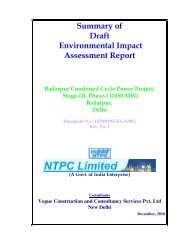EIA Studies of 3 Pre-Identified Hazardous Waste Disposal Sites in ...
EIA Studies of 3 Pre-Identified Hazardous Waste Disposal Sites in ...
EIA Studies of 3 Pre-Identified Hazardous Waste Disposal Sites in ...
You also want an ePaper? Increase the reach of your titles
YUMPU automatically turns print PDFs into web optimized ePapers that Google loves.
Rapid <strong>EIA</strong> <strong>Studies</strong> <strong>of</strong> 3 <strong>Pre</strong>-identified <strong>Hazardous</strong> <strong>Waste</strong> <strong>Disposal</strong> <strong>Sites</strong> <strong>in</strong> NCT - Delhi: Page<br />
No.16<br />
A HW landfill will be selected follow<strong>in</strong>g the guidel<strong>in</strong>es published by MOEF. The step by step<br />
procedure will be as follows:<br />
(i)<br />
(ii)<br />
Earmark<strong>in</strong>g a 'search area' tak<strong>in</strong>g '<strong>in</strong>to account the location <strong>of</strong> the waste generation units and a<br />
'search radius' (typically 5 to 250 km). The search area will be so chosen that it m<strong>in</strong>imises the<br />
number <strong>of</strong> HW landfills <strong>in</strong> any region or state.<br />
Identification <strong>of</strong> a list <strong>of</strong> potential sites on the basis <strong>of</strong>:<br />
(a)<br />
(b)<br />
availability <strong>of</strong> land<br />
collection <strong>of</strong> prelim<strong>in</strong>ary data<br />
(c) restrictions listed <strong>in</strong> the locational criteria (section 3.2.2).<br />
(iii)<br />
Collection <strong>of</strong> prelim<strong>in</strong>ary data as follows:<br />
(a)<br />
(b)<br />
(c)<br />
(d)<br />
(e)<br />
(f)<br />
(g)<br />
(h)<br />
(i)<br />
Topographic Maps: A topographic map will help f<strong>in</strong>d sites that are not on natural surface<br />
water dra<strong>in</strong>s or flood pla<strong>in</strong>s. Topographical maps may be procured from Survey <strong>of</strong> India.<br />
Soil Maps: These maps, primarily meant for agricultural use, will show the types <strong>of</strong> soil<br />
near the surface. They are <strong>of</strong> limited use as they do not show types <strong>of</strong> soil a few meter<br />
below the surface. They may be procured from Indian Agricultural Research Institute.<br />
Land Use Plans: These plans are useful <strong>in</strong> del<strong>in</strong>eat<strong>in</strong>g areas with def<strong>in</strong>ite zon<strong>in</strong>g<br />
restrictions. There may be restrictions on the use <strong>of</strong> agricultural land or on the use <strong>of</strong><br />
forest land for landfill purposes. Such maps are available with the Town Plann<strong>in</strong>g<br />
Authority or the Municipality.<br />
Transportation Maps: These maps, which <strong>in</strong>dicate roads and railways and locations <strong>of</strong><br />
airports, are used to determ<strong>in</strong>e the transportation needs <strong>in</strong> develop<strong>in</strong>g a site.<br />
Water Use Plans: Such maps are usually not readily available. A plan <strong>in</strong>dicat<strong>in</strong>g the<br />
follow<strong>in</strong>g items should be developed: private and public tubewells <strong>in</strong>dicat<strong>in</strong>g the capacity<br />
<strong>of</strong> each well, major and m<strong>in</strong>or dr<strong>in</strong>k<strong>in</strong>g water supply l<strong>in</strong>e(s), water <strong>in</strong>take wells located on<br />
surface water bodies, and open wells.<br />
Flood Pla<strong>in</strong> Maps: These maps are used to del<strong>in</strong>eate areas that are with<strong>in</strong> a 100 year<br />
flood pla<strong>in</strong>. Landfill sit<strong>in</strong>g must be avoided with<strong>in</strong> the flood pla<strong>in</strong>s <strong>of</strong> major rivers.<br />
Geologic Maps: These maps will <strong>in</strong>dicate geologic features and bedrock levels. A<br />
general idea about soil type can be developed from a geological map. Such maps can<br />
be procured from Geological Survey <strong>of</strong> India. ,<br />
Aerial Photographs / Satellite Imagery: Aerial photographs or satellite imageries may<br />
not exist for the entire search area. However such <strong>in</strong>formation may prove to be<br />
extremely helpful. Surface features such as small lakes, <strong>in</strong>termittent stream beds and<br />
current land use, which may not have been identified <strong>in</strong> earlier map searches, can be<br />
easily identified us<strong>in</strong>g aerial photographs.<br />
Ground Water Maps: Ground water contour maps are available <strong>in</strong> various regions which<br />
<strong>in</strong>dicate the depth to ground water below the land surface as well as regional ground<br />
water flow patterns. Such maps should be collected from Ground water Boards or M<strong>in</strong>or<br />
Irrigation Tubewell Corporations,<br />
(j) Ra<strong>in</strong>fall Data The monthly ra<strong>in</strong>fall data for the region should be collected from the Indian<br />
Meteorological Department.<br />
Environment Division, National Productivity Council, New Delhi<br />
1
















